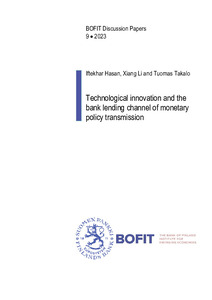Technological innovation and the bank lending channel of monetary policy transmission
Hasan, Iftekhar; Li, Xiang; Takalo, Tuomas (20.12.2023)
Numero
9/2023Julkaisija
Bank of Finland
2023
Julkaisun pysyvä osoite on
https://urn.fi/URN:NBN:fi-fe20231220156018Tiivistelmä
This paper studies whether and how banks’ technological innovations affect the bank lending channel of monetary policy transmission. We first provide a theoretical model in which banks’ technological innovation relaxes firms’ earning-based borrowing constraints and thereby enlarges the response of banks’ lending to monetary policy changes. To test the empirical implications, we construct a patent-based measurement of bank-level technological innovation, which can specify the nature of technology and tell whether it is related to the bank’s lending business. We find that lending-related innovations significantly strengthen the transmission of the bank lending channel.
Julkaisuhuomautus
NON-TECHNICAL SUMMARY
FOCUS
In response to the advancing competition from financial technologies (FinTech) in the financing market, banks have become increasingly enthusiastic about developing in-house technologies. How should banks’ technological innovation interact with the lending channel of monetary policy? What are the patterns of bank-level technology innovation and whether it alters the bank loan growth in response to monetary policy changes? This paper fills in the gap of the literature by linking technological innovation to the bank lending channel of monetary policy.
CONTRIBUTION
We first propose a theoretical model with earnings-based borrowing constraints in the spirit of Holmstrom and Tirole (1997), where a bank’s technological innovation relaxes firms’ earningsbased borrowing constraints and predicts that technological innovation amplifies the bank lending channel of monetary policy transmission. Then we construct a new measurement of banks’ use of new technologies via their technology patent applications and examine its impact on bank loan growth when interacted with monetary policy shocks. The measurement has two unique features. First, it can tell whether banks’ new technologies are lending-related or not. Second, it classifies the new technologies into the following six categories: AI, big data, cloud computing, digitalization, machine learning, and blockchain.
FINDINGS
First, we document that bank size, cost pressure, and exposure to BigTech demonstrate significant and positive associations with banks’ patenting. Second, lending-related technology innovation significantly strengthens the transmission of the bank lending channel, meanwhile, the effects of innovations that are unrelated to lending activities are ambiguous. When faced with an expansionary monetary policy shock, the more advanced the banks’ lending technologies,
the larger the increase in loan growth. Moreover, the transmission-enhancing effect is persistent and remains strong for ten quarters after the monetary policy shock.
FOCUS
In response to the advancing competition from financial technologies (FinTech) in the financing market, banks have become increasingly enthusiastic about developing in-house technologies. How should banks’ technological innovation interact with the lending channel of monetary policy? What are the patterns of bank-level technology innovation and whether it alters the bank loan growth in response to monetary policy changes? This paper fills in the gap of the literature by linking technological innovation to the bank lending channel of monetary policy.
CONTRIBUTION
We first propose a theoretical model with earnings-based borrowing constraints in the spirit of Holmstrom and Tirole (1997), where a bank’s technological innovation relaxes firms’ earningsbased borrowing constraints and predicts that technological innovation amplifies the bank lending channel of monetary policy transmission. Then we construct a new measurement of banks’ use of new technologies via their technology patent applications and examine its impact on bank loan growth when interacted with monetary policy shocks. The measurement has two unique features. First, it can tell whether banks’ new technologies are lending-related or not. Second, it classifies the new technologies into the following six categories: AI, big data, cloud computing, digitalization, machine learning, and blockchain.
FINDINGS
First, we document that bank size, cost pressure, and exposure to BigTech demonstrate significant and positive associations with banks’ patenting. Second, lending-related technology innovation significantly strengthens the transmission of the bank lending channel, meanwhile, the effects of innovations that are unrelated to lending activities are ambiguous. When faced with an expansionary monetary policy shock, the more advanced the banks’ lending technologies,
the larger the increase in loan growth. Moreover, the transmission-enhancing effect is persistent and remains strong for ten quarters after the monetary policy shock.
